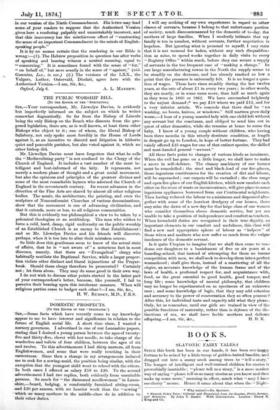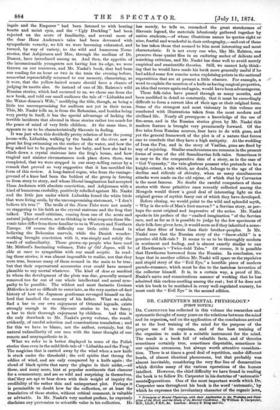BOOKS.
SLAVONIC FAIRY TA LES.t
SINCE this book has been in -our hands, it has been aut....happy fortune to be seized by a little troop of golden-haired bandits, tend dragged out into a sunny nook among trees to ":tell a :story." The -hunger of intelligent and well-trained children for stories is proverbially insatiable ; " please tell us a story," is a mere modest way of saying " please tell us as many stories as you know and then make up some more," meaning in effect, -much what " may have one cherry " means. .Hence it came about that when the " Night-
• Why nnjost?—En. Spectator.
t Slavonic Fairy Tales: Collected and Translated from the Russian,-Polish,SesWan, and Bohemian. By John T. Katalr6. With Illustrations. London: -Henry S. King and Co. ingale and the Emperor " had been listened to with beating hearts and moist eyes, and the " Ugly Duckling" had been rejected on the score of familiarity, and several more of the dear Hans Andersen's tales had been devoured with sympathetic voracity, we felt we were becoming exhausted, and . turned, by way of variety, to the wild and humorous Norse stories, that Asbjornsen and Moe, through the medium of Dr. Dasent, have introduced among us. And then, the appetite of the inconscionable youngsters not having lost its edge, we were thrown on our resources, and Mr. Naake's book, that had been our reading for an hour or two in the train the evening before, somewhat reproachfully returned to our memory, clamouring, as it were, that the yellow-haired senate should have a chance of judging its merits also. So instead of one of Mr. Ralston's wild Russian stories, which had occurred to us, we chose one from the new book, and told our small audience the tale of " Lidushka and the Water-demon's Wife," modifying the title, though, as being a little too uncompromising for auditors not yet in their teens. This, Mr. Naake tells us, is from the Bohemian, and besides being very pretty in itself, it has the special advantage of lacking the terrible incidents that abound in these stories rather too much for the peace of mind of very little children. At the same time, it appears to us to be characteristically Slavonic in feeling.
It was just when this decidedly pretty relation of how the young house-wife, Lidushka, walking by the banks of the river, saw a great fat frog swimming on the surface of the water, and how the frog asked her to be godmother to her baby, and how she had to climb down a crystal staircase into the frog's house, and how tragical and sinister circumstances took place down there, was completed, that we were stopped in our story-telling career by a remark that proved so very suggestive that it has moulded the
form of this review. A long-haired rogue, who from the vantage- ground of a knee had been the boldest of the group in forcing us from story to story, and whose liberal imagination had accepted Hans Andersen with absolute conviction, and Asbjornsen with a kind of humorous credulity, positively rebelled against Mr. Naake and the little jars under which Lidushka found the white birds that were living souls, by the uncompromising statement, " I don't believe it's true !" The trolls of the Norse Tales were not nearly so staggering to his faith as the crystal staircase and the frog that talked. This small criticism, coming from one of the acute and natural judges of stories, set us thinking in what respects these Sla- vonic tales differ from those familiar to us in Western and Northern Europe. Of course the difficulty our little critic found in believing the Bohemian marvels, while the Danish wonder- working brought conviction with it, was simply and solely the result of unfamiliarity. Those grown-up people who have read Mr. Mitford's fascinating volumes, Tales of Old Japan, will be able at once to sympathise with our small sceptic. In read- ing those stories, it was almost impossible to realise, not that they were true, because many of them seemed in the main to be true, but that their supernatural accessories ever could have seemed plausible to any mortal whatever. The kind of dens ex machinfi to whom the development of the plots was due, generally seemed removed too far out of our whole intellectual and moral sym- pathy to be possible. The wildest and most fantastic German Mtihrchen is not so difficult to enter into, as the very-matter-of-fact history of how the Japanese gentleman revenged himself on the lord that insulted the memory of his father. What we adults find a bar to our own enjoyment of Oriental legends, exists strongly enough in the Slavonic stories to be, we fancy, a bar to their thorough enjoyment by children. And this is the only drawback to Mr. Naake's pretty volume, the result, evidently, of careful selection and conscientious translation ; and for this we have to blame, not the author, certainly, but the natural unfamiliarity of our race with the inner thought of one remote and unsympathetic to it.
What we refer to is better displayed in some of the Polish stories than even in the mild little tale of " Lidushka and the Frog."
The magician that is carried away by the wind when a new knife is stuck under the threshold ; the evil spirits that throng the eddies of wind, and are only conquered by a knife again ; the cloud of black spirits that carry the plague in their midst,—all these, and many more, hint at popular sentiments that clamour for a commentary, and are so wild and surprising in themselves, thaf.they are apt to bear down with their weight of inquiry the credibility of the rather thin and unimportant plot. Perhaps it is permissible to doubt how far the collection, or at least the translation of these stories, without critical comment, is valuable or advisable. In Mr. Naake's very modest preface, he expressly disclaims any to scientific value in his collection. He has merely, he tells us, ransacked the great storehouses of Slavonic legend, the materials laboriously gathered together by native students,—of whose illustrious names he quotes eight or nine, fearful and wonderful in their orthography,—and out of these he has taken those that seemed to him most interesting and most characteristic. It is not every one who, like Mr. Ralston, can preserve these quaint flies in an enduring amber of delicate and searching criticism, and Mr. Naake has done well to avoid merely empirical and unscientific theories. Still, we cannot help think- ing that he would have made his book more generally useful if he had added some few concise notes explaining points in the national superstition that are at present a little obscure. For example, a word to explain the mention of a knife as having magical properties, an idea that recurs again and again, would have been advantageous. These folk-tales have passed through so many mouths, and been modified in detail so constantly, that it must be exceedingly difficult to form a correct idea of their age or their original form.
Some of the strangest and most visionary in this volume are cumbered with illustrations taken from the most modern and civilised life. Nearly all presuppose a knowledge of the use of fire-arms, and in the Russian stories given by Mr. Naake this modern feature is brought very prominently forward. Of the five tales from Russian sources, four have to do with guns, and yet the general framework of the plot is of a nature that forces one to conclude that they have a high antiquity. At the wedding of Ivan the Pea, and in the story of Vasilisa, guns are fired by way of rejoicing. Similar anachronisms are common in the present forms of some of the old Scandinavian folk-tales. Sometimes it is easy to fix the comparative date of a story, as in the case of
" Gol Voyansky," the vain-glorious peasant who pretends to be a. knight-errant, a tale which, no doubt, belongs to the age of the
decline and ridicule of chivalry, when so many simultaneous
attacks were made on the old regime, of which that by Cervantes is the most famous. No doubt the careful comparison of these
stories with those primitive ones recently collected among the
Mongols would throw -a good deal of interesting light on the original germs of mythic fancy out of which they have developed. Before closing, we would point to the wild and splendid myth, " Why is the sole of Man's foot uneven? " a Servian story, as per-
baps the most original and impressive of the series. Mr. Nita& speaks in his preface of the " exalted imagination " of the Servian race, and as far as it is possible to judge by the few specimens of their folk-lore given here, it would seem as if they inherited a some- what finer fibre of brain than their brother-peoples. Is Mr. Naake sure that the Russian story of the " Snow-child" is a genuine old folk-tale ? It seems to us to be thoroughly modern in sentiment and feeling, and is almost exactly similar to one of Hawthorne's "Twice-told Tales." Of course, it is possible that Hawthorne borrowed from the Russian. In conclusion, we hope that in another edition Mr. Naake will spare us the repulsive and stupid story of the " Evil Eye," a horrible piece of modem pseudo-romance, which must be due to the tasteless invention of the collector himself. It is, in a certain way, a proof of Mr. Naake's naive and conscientious manner of working that he has admitted this cuckoo-nestling among the rest ; but if he does not wish his book to be mutilated in every well-regulated nursery, he must omit the " Evil Eye " in the second edition.



































 Previous page
Previous page